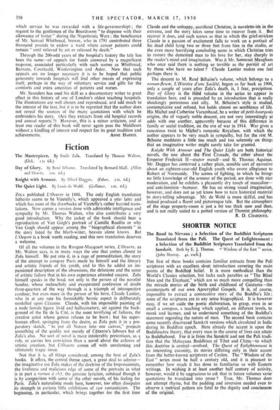Hospital in Soho
BY most people, who have no intimate and personal connection with them, hospitals are usually taken very much for granted as necessary but somewhat regrettable institutions (in much the same category as dentists) to be avoided whenever possible and only resorted to in an emergency. Unlike Government departments, hospitals have no public relations officers, and it is not until a journalist of Mr. Saunders's calibre takes up their story that we realise how valuable and venerable a part in the social history of England is played by her hospitals.
Although the Middlesex is by no means the oldest English has pital—it was founded in 1745—it is the inheritor of a long tradition of charity and healing, for on the site of the present buildings in Soho there once stood the leper hospital of St. Giles, founded in 1101 by Queen Matilda, which carried on its merciful wcrk until Henry VIII dissolved the monasteries and disposed of their lands. In the year of Culloden the Middlesex Hospital was founded, to minister to " the sick and lame Of Soho," in two small houses in Windmill Street, which can still in seen today. At the time of the great cholera outbreak in London of 1854, Florence Nightingale undu- took the superintendence of the cholera patients who were brought into the hospital from the Soho district, a poor and vicious neigh- bourhood where the plague spread like wildfire, and in the war is of the Middlesex she learned much that was to stand her in good stead at Scutari.
Another great personality associated with the hospital was Elizabeth Garrett Anderson, the first Englishwoman to take a medical degree, who was'only allowed into the wards by maintaining the fiction that she was a nurse. Surprisingly,' it was not until 1947 that women medical students were admitted to the hospital. Perhaps inevitably, it is the story of the early years of the Middlesex which make the most fascinating reading—the acquisition in 1754 from one Mr. Berners of the present site, then " a. good place for snipe shooting," a place of ponds and marshlands ; David Garrick giving benefit performances to raise funds for the building (for which service he was rewarded with a life-governorship) ; the request to the gentlemen of the Boardroom " to dispense with their allowance of butter " during the Napoleonic Wars ; the beneficence of Mr. Samuel Whitbread, brewer, who in 1791 contributed three thousand pounds to endow a ward where cancer patients could remain " until relieved by art or released by death."
Through the 200-odd years of the hospital's history the tale has been the same—of appeals for funds answered by a magnificent response, associated particularly with such names as Whitbread, Barnato, Courtauld, Woolavington and Astor. Now that such appeals are no longer necessary it is to be hoped that public generosity towards hospitals will find other means of expressing itself, perhaps in the way of voluntary service and gifts for the comforts and extra amenities of patients and nurses.
Mr. Saunders has used his skill as a documentary writer to great effect in this history of one of London's oldest teaching hospitals. The illustrations are well chosen and reproduced, and add much to the interest of the text, but it is to be regretted that the author does not reveal the sources of the many quotationi with which he embroiders his story. (Are they extracts from old hospital records and annual reports ?) However, this is a minor criticism, and at least one reader of this book will never again pass the Middlesex without a kindling of interest and respect for its great tradition and



































 Previous page
Previous page